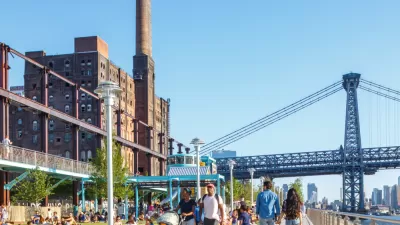Steven Malanga writes about the resurrection of Bushwick, a Brooklyn neighborhood, from its decrepit past.
'These days, when Morris Todash walks the streets of Bushwick, a two-square-mile neighborhood of 100,000 people in central Brooklyn, he likes what he sees. On the long-abandoned seven-acre site of the former Rheingold Brewery, new two-family homes and condominiums have sprung up. On the side streets along Broadway-not so long ago, pockmarked with desolate lots where stray dogs wandered amid burned-out cars-more new homes arise and old ones get impressive face-lifts. New businesses-an organic grocery store, a fashionable restaurant-seem to be opening on every corner. Todash, whose insurance firm has served the neighborhood for more than 40 years, can hardly believe that this is the same Bushwick that became synonymous with urban chaos during the late 1960s and early 1970s, ravaged by fires, rioting, and looting until it resembled a war zone. "When I first came here to open a business, this was a shopping destination for all of Brooklyn," Todash says of the neighborhood's commercial district. "After the looting, no one wanted to come here any more."
Often described by residents as a forgotten neighborhood, Bushwick was once a solid blue-collar community. But starting in the 1960s, a steady barrage of demographic changes and ruinous Great Society policies battered it down. So total was the devastation that even as New York began rebounding in the mid-1990s, Bushwick remained largely untouched by gentrification. Only recently-after years of tireless work by government (especially the police), local groups, and the private sector-has the revitalization of this once-proud neighborhood begun."
FULL STORY: The Death and Life of Bushwick

Maui's Vacation Rental Debate Turns Ugly
Verbal attacks, misinformation campaigns and fistfights plague a high-stakes debate to convert thousands of vacation rentals into long-term housing.

Planetizen Federal Action Tracker
A weekly monitor of how Trump’s orders and actions are impacting planners and planning in America.

In Urban Planning, AI Prompting Could be the New Design Thinking
Creativity has long been key to great urban design. What if we see AI as our new creative partner?

King County Supportive Housing Program Offers Hope for Unhoused Residents
The county is taking a ‘Housing First’ approach that prioritizes getting people into housing, then offering wraparound supportive services.

Researchers Use AI to Get Clearer Picture of US Housing
Analysts are using artificial intelligence to supercharge their research by allowing them to comb through data faster. Though these AI tools can be error prone, they save time and housing researchers are optimistic about the future.

Making Shared Micromobility More Inclusive
Cities and shared mobility system operators can do more to include people with disabilities in planning and operations, per a new report.
Urban Design for Planners 1: Software Tools
This six-course series explores essential urban design concepts using open source software and equips planners with the tools they need to participate fully in the urban design process.
Planning for Universal Design
Learn the tools for implementing Universal Design in planning regulations.
planning NEXT
Appalachian Highlands Housing Partners
Mpact (founded as Rail~Volution)
City of Camden Redevelopment Agency
City of Astoria
City of Portland
City of Laramie



























